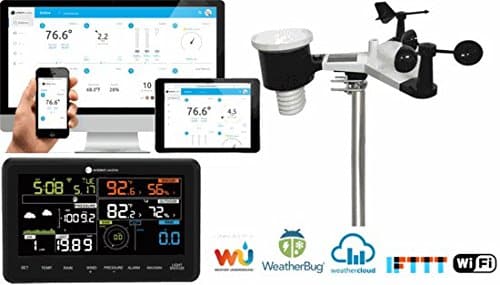In today’s digital age, we rely heavily on technology to provide us with real-time information.
And when it comes to monitoring and forecasting the weather, weather stations play a crucial role. But have you ever wondered if these weather stations need wifi to function accurately?
Well, the answer might surprise you. While wifi can undoubtedly enhance the capabilities of weather stations, it is not an absolute necessity.
This article will explore why weather stations can function without a Wi-Fi connection and how they can still provide us with valuable weather data.
So, let’s dive in and discover the fascinating world of weather stations!
Review contents
Benefits of Weather Stations with wifi
Real-time data
Having a weather station with Wi-Fi connectivity allows you to access real-time data about the weather conditions in your area.
You can instantly get information about temperature, humidity, wind speed, rainfall, and more with just a few clicks. This immediate access to up-to-date data is invaluable for monitoring crops, planning outdoor activities, or making informed decisions about your day.
Remote monitoring and control
One of the most significant advantages of wifi-enabled weather stations is the ability to monitor and control your station remotely. Whether at home, in the office, or even on vacation, you can effortlessly check the weather conditions at your location.
This remote monitoring feature provides convenience and peace of mind, especially for those who rely on accurate weather data for their livelihood or personal safety.
Data accessibility and sharing
Another significant benefit of weather stations with wifi is the ease of accessing and sharing data. Traditional weather stations often require manual reading and recording of data, but with Wi-Fi connectivity, your station can transmit the data directly to your smartphone, tablet, or computer.
This accessibility allows you to quickly analyze and interpret the information, share it with others, or even integrate it into existing weather networks for a broader scope of data analysis.
Integration with other smart devices
Wifi-enabled weather stations can seamlessly integrate with other smart devices in your home or office.
By connecting your weather station to an intelligent assistant such as Amazon Alexa or Google Home, you can effortlessly receive weather updates, set alerts for specific weather conditions, or even control other smart devices based on weather data.
This integration enhances your weather station’s overall functionality and convenience and enables you to create a truly interconnected and intelligent environment.
Weather Stations without wifi
Limited data access
Weather stations without Wi-Fi connectivity often require manual data collection. This means physically going to the station and reading and recording the data yourself.
This is time-consuming and limits your ability to access real-time data and make informed decisions based on the latest weather conditions.
Manual data collection
Manual data collection can be inconvenient and prone to human error. It also requires regular visits to the weather station to ensure accurate data collection.
Without Wi-Fi connectivity, you may miss out on certain weather events or fail to obtain data during specific periods, leading to a less comprehensive understanding of the weather patterns in your area.
No remote monitoring
Traditional weather stations without wifi do not offer the convenience of remote monitoring. This means you cannot check the weather conditions unless you visit the weather station. This lack of remote monitoring can be a significant drawback for those who rely on accurate and timely weather information. It may hinder their ability to plan and make informed decisions.
Inconvenience of data retrieval
With weather stations lacking Wi-Fi connectivity, retrieving data can be cumbersome. Data must be manually transferred from the station to a computer or other storage devices for analysis. This additional step can be time-consuming and may deter some users from regularly accessing and utilizing the valuable weather data collected by their station.
Wifi-enabled Weather Stations
Quick and easy setup
Wifi-enabled weather stations are designed to be user-friendly and offer a quick and easy setup process. With intuitive instructions and user-friendly interfaces, you can have your station up and running quickly.
This ease of setup ensures that even those with limited technical knowledge can benefit from wifi-enabled weather stations’ advanced features and capabilities.
Continuous data transmission
One of the significant advantages of wifi-enabled weather stations is the continuous transmission of data. As long as your station is connected to a reliable Wi-Fi network, it will continuously transmit data to your chosen devices. This uninterrupted flow of data allows you to have a real-time understanding of the weather conditions without manually collecting and recording data.
Reduced maintenance efforts
Wifi-enabled weather stations often have advanced features such as automatic data syncing and firmware updates. These features significantly reduce the maintenance efforts required to keep your station running smoothly. With automatic data syncing, you no longer need to transfer data to your computer or storage devices manually. Additionally, firmware updates can be easily installed over a Wi-Fi connection, ensuring your station stays up-to-date with the latest features and improvements.
Advanced data analysis
With wifi-enabled weather stations, you have access to a wealth of data that can be used for advanced analysis. Whether you are a weather enthusiast, a researcher, or an agricultural professional, Wi-Fi connectivity allows you to perform in-depth data analysis, identify patterns or trends, and make data-driven decisions. By utilizing advanced data analysis techniques, you can gain deeper insights into weather patterns and optimize your operations or activities accordingly.
Connectivity Options for Weather Stations
Wifi connectivity
Wi-Fi connectivity is the most common and convenient option for weather stations. It allows seamless data transmission, remote monitoring, and integration with other smart devices. With Wi-Fi connectivity, you can easily access your weather data from anywhere with an internet connection and make informed decisions based on real-time information.
Cellular network
Weather stations can utilize a cellular network for data transmission in locations where Wi-Fi connectivity is scarce or unreliable. Weather stations can send data via cellular networks by incorporating a SIM card and cellular modem, providing a reliable connection and ensuring continuous data transmission even in remote areas.
Ethernet connection
In cases where a stable and high-speed internet connection is required, weather stations can be connected to the internet via an Ethernet cable. This option is handy for weather stations with reliable and high-performance network infrastructure in institutional or commercial settings.
Bluetooth technology
Some weather stations offer Bluetooth connectivity, allowing for short-range wireless communication with compatible devices. While Bluetooth technology may not provide the same level of convenience as wifi or cellular connectivity, it can be helpful for local data transfer or connecting to nearby devices without needing an internet connection.
Integrated data logging
In situations where internet connectivity is not available or required, weather stations can be equipped with integrated data logging capabilities.
These stations store the collected data internally in a memory card or onboard memory, allowing for later retrieval and analysis. Integrated data logging is particularly useful in sporadic or unreliable internet connectivity.
Factors to Consider When Choosing a Weather Station
Location and accessibility
Consider the location and accessibility of your weather station when making a decision. Assess whether wifi, cellular, or Ethernet connectivity is readily available and reliable at the intended installation site.
Additionally, consider any specific factors unique to your location, such as potential obstructions to the Wi-Fi signal or extreme weather conditions, that may affect the performance of the weather station.
Budget and cost
Determine your budget and research the cost of different weather station options. Wifi-enabled weather stations may come at a higher price than traditional ones due to their advanced features and connectivity options.
Evaluate the features and capabilities that are most important to you and find a weather station that offers the best balance between cost and functionality.
Data accuracy and reliability
Ensure that the weather station you choose provides accurate and reliable data. Look for testimonials or reviews from other users to gauge the performance and accuracy of the station. Additionally, consider the manufacturer’s reputation and the quality of their products. Remember that accurate and reliable data is crucial for making informed decisions and maximizing the benefits of a weather station.
User requirements and preferences
Identify your specific requirements and preferences when it comes to a weather station. Do you need advanced data analysis capabilities? Are you looking for a compact and portable station? Do you prefer a station that integrates easily with other smart devices? By understanding your specific needs and preferences, you can narrow your options and choose a weather station that aligns with your goals.
Future expansion and integration
Consider the potential for future expansion and integration when selecting a weather station. Will you need additional sensors or modules in the future? Are you planning to integrate your weather station with other smart devices or platforms? Choosing a weather station that allows for easy expansion and integration ensures that you can adapt to changing needs and take advantage of new technologies or advancements in the future.
Wifi Weather Stations vs Traditional Weather Stations
Data accuracy and reliability
With continuous data transmission and advanced sensors, Wi-Fi weather stations generally offer higher data accuracy and reliability than traditional weather stations. Manual data collection and potential human errors can introduce inaccuracies in traditional stations. In contrast, Wi-Fi weather stations eliminate these issues and provide real-time, precise data for better decision-making.
Data transmission and accessibility
Wifi weather stations simplify data transmission and accessibility by automatically transmitting data to your connected devices. Traditional weather stations often require manual data retrieval and transfer, which can be time-consuming and error-prone. Wi-Fiwifiectivity lets you instantly access your weather data anytime and anywhere, making monitoring conditions and planning easier.
Ease of installation and operation
Wifi Wifiher stations are generally easier to install and operate than traditional stations. They come with user-friendly interfaces and intuitive setup processes, eliminating the need for specialized technical knowledge or professional assistance. On the other hand, traditional weather stations may require manual calibration, wiring, and complex installations, which can be challenging for inexperienced users.
Maintenance and updates
Wifi Wifiher stations typically require less maintenance compared to traditional stations. With automatic data syncing and firmware updates, wifi-enabled stations minimize the need for manual data management and keep your station up-to-date with the latest features and improvements. Traditional stations often require regular manual data transfer and may not offer firmware updates or advanced features.
Applications of Weather Stations with Wi-Fiwificulture and farming
Weather stations with Wi-Fiwifiectivity play a vital role in agricultural operations and farming. Farmers can monitor crucial weather parameters such as temperature, humidity, and rainfall to optimize irrigation schedules, assess crop health, and anticipate potential pest outbreaks. Real-time weather data allows farmers to make informed decisions about planting, harvesting, and resource management, leading to increased productivity and reduced costs.
Weather forecasting and research
Wifi Wifi stations are valuable tools for weather forecasting and research purposes. Meteorologists and researchers gain insights into local weather patterns and trends by collecting and analyzing real-time weather data. This data contributes to the accuracy and reliability of weather forecasts and helps study climate change, atmospheric phenomena, and other weather-related research areas.
Outdoor activities and sports
Wifi-enabled weather stations are beneficial for individuals engaged in outdoor activities and sports. Whether planning a hiking trip, a day of fishing, or a round of golf, having access to real-time weather data can enhance your safety and enrich your experience. By monitoring weather conditions, you can make informed decisions about wearing appropriate clothing, timing activities, or even canceling or rescheduling plans to avoid adverse weather conditions.
Home weather monitoring
Wifi Wifiher stations provide a convenient solution for home weather monitoring. Installing a weather station in your backyard or rooftop allows you to monitor local weather conditions and receive real-time updates from the comfort of your home. This allows you to plan outdoor activities, adjust temperature settings, or satisfy your curiosity about the weather.
Industrial and commercial applications
Weather stations with Wi-Fiwifiectivity have various industrial and commercial applications. They are used in construction, aviation, transportation, and energy sectors to assess weather-related risks and optimize operations accordingly. Real-time weather data enables better decision-making, enhances safety protocols, and improves the overall efficiency of these industries.
Popular Wifi-enabled Weather Stations
Davis Instruments Vantage Pro2 with Wifi
wifiDavis Instruments Vantage Pro2 with Wifi wifi is a highly acclaimed weather station known for its accuracy, durability, and connectivity options. It provides various meteorological measurements, including temperature, humidity, wind speed, and rainfall. With its integrated Wi-Fi, you can easily access and analyze the weather data from your connected devices.
Ambient Weather WS-2000 Smart Weather Station
The Ambient Weather WS-2000 Smart Weather Station offers comprehensive weather measurements and features. Its Wi-Fiwifiectivity allows real-time data transmission to your preferred devices, enabling remote monitoring and analysis. The station also integrates with popular weather platforms and smart home systems, offering a seamless and interconnected experience.
AcuRite Atlas Weather Station
The AcuRite Atlas Weather Station is a feature-rich weather station with wifi connectivity. It offers a multitude of weather measurements, including temperature, humidity, wind speed, wind direction, and rainfall. The station’s Wi-Fi flexibility allows you to access your weather data anywhere, providing remote monitoring and analysis convenience.
La Crosse Technology C85845-1
The La Crosse Technology C85845-1 is a budget-friendly Wi-Fi water station with accurate and reliable weather measurements.
Its easy-to-use interface and straightforward Wi-Fi make monitoring local weather conditions effortless. The station offers key weather parameters such as temperature, humidity, wind speed, and rainfall, making it a popular choice for home weather enthusiasts.
Security and Privacy Concerns of Wifi-enabled Weather Stations
Data encryption and protection
One of the primary concerns with wifi-enabled weather stations is the security and protection of the transmitted data.
Choosing a weather station that utilizes data encryption methods, such as Secure Sockets Layer (SSL) or Transport Layer Security (TLS), is crucial to ensure that your weather data is encrypted during transmission and protected from unauthorized access.
Secure network connectivity
Ensuring that your weather station is connected to a secure and password-protected Wi-Fi network is essential to mitigate security risks.
Strong network security measures, such as WPA/WPA2 encryption and a unique and secure network password, help minimize the risk of unauthorized access to your weather station and its transmitted data.
Privacy policies and data sharing
Before purchasing a Wi-Fi station, review the manufacturer’s privacy policies and practices regarding data sharing.
Ensure you know how your weather data is collected, stored, and shared. Look for transparent privacy policies prioritizing user consent and providing data-sharing options.
Cybersecurity threats and vulnerabilities
Wii-enabled weather stations may be vulnerable to cybersecurity threats like any other connected device. It is crucial to regularly update the firmware of your weather station to protect against potential vulnerabilities and exploits.
Stay informed about security best practices and follow recommended guidelines to minimize the risk of cyber-attacks.
Future Developments and Trends in Wi-Fi wifiher Stations
Integration with IoT devices
Wi-Fi stations will likely integrate further with other Internet of Things (IoT) devices. This integration enables data exchange and coordination between weather stations and other smart devices, contributing to a more interconnected and automated environment.
For example, weather data from a station could automatically adjust the irrigation system in an intelligent garden or trigger alerts on a home assistant device.
Artificial Intelligence and machine learning
The utilization of Artificial Intelligence (AI) and machine learning algorithms holds excellent potential for improving the capabilities of Wi-Fi stations.
These technologies can enhance data analysis and weather prediction accuracy, enabling more accurate forecasts, early warning systems for severe weather events, and personalized weather alerts based on individual preferences and historical data.
Improved energy efficiency
Wi-Fiwifiher station manufacturers will likely focus on improving energy efficiency as technology advances.
This may involve using energy-saving components, optimizing power consumption strategies, or incorporating renewable energy options such as solar panels to power the weather station.
Enhanced energy efficiency reduces the environmental impact and allows for longer-lasting or portable weather stations.
Cost reduction and accessibility
Over time, the costs associated with Wi-Fi stations are expected to decrease, making them more accessible to a broader range of users.
As the demand for weather stations increases, economies of scale and technological advancements will likely drive down production costs. This reduced cost will make Wi-Fi water stations more affordable and available to individuals, educational institutions, and smaller businesses.
In conclusion, weather stations with Wi-Fiwifiectivity offer numerous benefits over traditional stations.
The real-time data, remote monitoring and control, data accessibility and sharing, and integration with other smart devices make wifi-enabled weather stations a valuable tool for various applications. When choosing a weather station, consider location, budget, data accuracy, user requirements, and future expansion possibilities.
Wifi-enabled weather stations provide higher data accuracy, simplified data transmission, accessibility, ease of installation and operation, and reduced maintenance efforts compared to traditional stations.
They find applications in agriculture, weather forecasting, outdoor activities, home weather monitoring, and industrial and commercial sectors. Popular wifi-enabled weather stations include the Davis Instruments Vantage Pro2, Ambient Weather WS-2000, AcuRite Atlas, and La Crosse Technology C85845-1.
It is crucial to address security and privacy concerns related to wifi-enabled weather stations and stay updated on future developments and trends, such as integration with IoT devices, artificial intelligence, improved energy efficiency, and cost reduction.








































